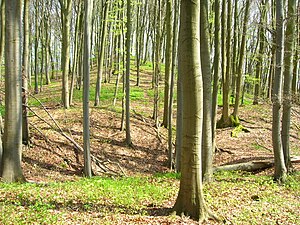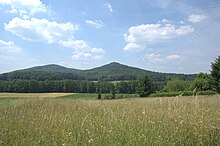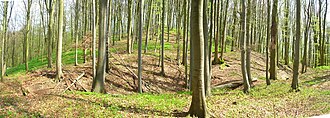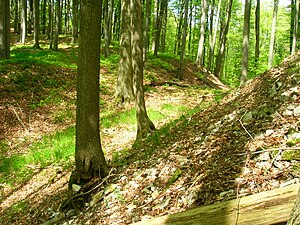Burgstall Little Hansgörgel
| Burgstall Little Hansgörgel | ||
|---|---|---|
|
Burgstall Kleiner Hansgörgel - view from the west |
||
| Alternative name (s): | Lower Crumbach Castle stable | |
| Creation time : | probably during the 13th century | |
| Castle type : | Höhenburg, spur location | |
| Conservation status: | Burgstall | |
| Place: | Hersbruck -Altensittenbach- "Little Hansgörgel" | |
| Geographical location | 49 ° 31 '46.6 " N , 11 ° 24' 24" E | |
| Height: | 553 m above sea level NN | |
|
|
||
The castle stable Kleiner Hansgörgel , also called Burgstall Unterkrumbach , was a high medieval aristocratic castle of unknown class to the northwest of Hersbruck in the Middle Franconian district of Nürnberger Land in Bavaria , Germany . The castle is almost completely gone, very few remains, such as some stone walls and two moats, testify to it.
Geographical location
The place of the abandoned hill castle is in the western area of the Hersbrucker Alb , part of the Frankenjura low mountain range , on the highest point of the spur crest of the Kleiner Hansgörgel , about 2000 meters west-southwest of the Evangelical-Lutheran parish church Sankt Margaretha in Unterkrumbach and about 2450 meters north-northwest of the Evangelical Parish church Sankt Thomas in Altensittenbach, a district of Hersbruck . At the confluence of the Sittenbach and the Pegnitz, the little Hansgörgel jumps out like a spur to the southeast from the adjacent plateau. On his spur dome in 553 m above sea level. NN height, the castle was situated about 200 meters above the valley of the Pegnitz.
history
There is no historical information about the castle, neither its builder nor the name is known. It may be related to the Lords of Krumbach, a vassal family of the Lords of Rothenberg, in 1236 a Reinmar von Crumbach was mentioned. However, there is no documentary evidence for this. Judging by the size of the castle complex, however, its builder must have been significant. Finds of ceramics and mortar remnants refer the castle to the 13th century.
The castle complex was located in the area of a prehistoric hilltop settlement. The place of the castle is densely wooded, only the neck ditch with inner wall and a section ditch that separated the outer bailey from the main castle have survived. A non-signposted hiking trail leads to the freely accessible Burgstall.
The ground monument recorded by the Bavarian State Office for the Preservation of Monuments as a settlement of prehistoric times and medieval castle stables bears the monument number D-5-6434-0023.
Description of the castle stables
The castle stood on the spur at the highest point of the so-called Kleiner Hansgörgel. It had a considerable size of 125 by 90 meters and consisted of a lower lower castle and an upper castle on an oval plateau at the top of the mountain spur. The area of the former castle has a triangular shape and narrows from the neck ditch with about 90 meters width to the main castle to about 40 meters.
If you approach the Burgstall from the north-west, you first walk through the 90-meter-long and up to four-meter-deep neck ditch with the one-meter-high wall on the inside, the rest of the collapsed curtain wall. After the neck ditch you stand in the area of the lower castle, which rises slightly towards the upper castle. After 55 meters there is a second trench, which is semicircular around the oval upper castle. A sickle-shaped ledge, presumably a berm , is on its outside.
The upper castle with an oval floor plan and the dimensions of about 33 by 20 meters stood at the highest point of the facility, about 2.50 meters above the bottom of the second trench. You can still find pieces of mortar and ceramic shards there. On the opposite east side of the upper castle, 2.50 meters lower, there is a second berm that ends the castle. In the entire area of the abandoned castle, no building remains have been preserved, and the remains of the wall are no longer visible.
literature
- Ferdinand Leja: Hersbruck-Altensittenbach: The castle stable on the small Hansgörgel . In: Alfried Wieczorek (Hrsg.): Excursions to archeology, history and culture in Germany. Volume 52: Nuremberg and Nürnberger Land - excursion destinations between Pegnitz and Franconian Alb . Konrad Theiss Verlag, Stuttgart 2010, ISBN 978-3-8062-2368-2 , pp. 165-167.
- Robert Giersch, Andreas Schlunk, Berthold Frhr. von Haller: Castles and mansions in the Nuremberg countryside . Published by the Altnürnberger Landschaft eV, Lauf an der Pegnitz 2006, ISBN 3-00-020677-9 , pp. 461–462.
- Walter Heinz: Former castles in the vicinity of the Rothenberg, part 2 (Vom Rothenberg and its vicinity, issue 15/2) . Published by the Heimatverein Schnaittach e. V., Schnaittach 1992, pp. 106-108.
- Wilhelm Schwemmer: The art monuments of Middle Franconia. Volume X: District of Hersbruck . R. Oldenbourg Verlag, Munich 1959, p. 214.
- Hellmut Kunstmann : Communications of the Altnürnberger landscape . Published by the Altnürnberger Landschaft eV, December 1953, 2nd year volume 3, pp. 12-14.
- Ruth Bach-Damaskinos, Jürgen Schnabel, Sabine Kothes: Palaces and castles in Middle Franconia . Verlag A. Hofmann, Nuremberg 1993, ISBN 3-87191-186-0 , p. 187.
Web links
Individual evidence
- ^ Topographic map 1: 25000, sheet 6434 Hersbruck
- ^ Location of the Burgstall in the Bavaria Atlas
- ^ Wilhelm Schwemmer: The art monuments of Middle Franconia. Volume X: District of Hersbruck. 1959, p. 214.
- ^ A b Robert Giersch, Andreas Schlunk, Berthold Frhr. von Haller: Castles and mansions in the Nuremberg countryside. 2006, p. 461.
- ^ Burgstall Kleiner Hansgörgel on the website of the Bavarian State Office for Monument Preservation






